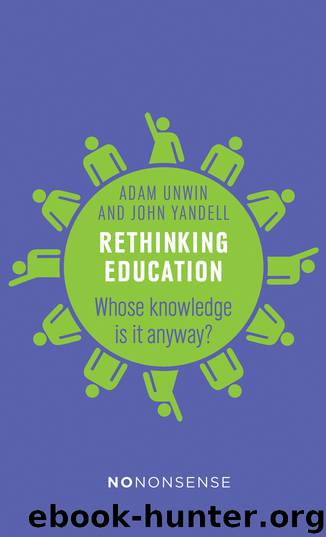NoNonsense Rethinking Education by Adam Unwin

Author:Adam Unwin
Language: eng
Format: epub
ISBN: 9781780263106
Publisher: New Internationalist
Published: 2016-02-27T16:00:00+00:00
History and school history: worlds apart
Wineburg’s experiment involved eight professional historians and eight high-school students.1 The professional historians had widely different areas of special interest; the high school students were all high-achieving and had all chosen history courses. Each participant was presented with a series of documents relating to the Battle of Lexington, an episode in the American Revolutionary War. The documents ranged from first-hand accounts to a school textbook and a fictional treatment of the battle. The participants were asked to do two things: first, to provide a spoken commentary (thinking aloud, as it were) while they read the documents, so that their thought processes, their immediate responses to the texts, could be recorded; second, to rank the documents in order of their trustworthiness.
What emerged from this experiment was a startling difference between the two groups. The historians ranked the school textbook as the least trustworthy of all the documents, even less reliable than the fictional account. The high-school students, on the other hand, rated the school textbook as the most reliable of all.
Why was this? The think-aloud process revealed that the historians and the high-school students were reading the documents in different ways, for entirely different purposes. For the high-school students, reading was a process of comprehension, of getting at the facts; when the historians read the documents, they were interrogating them to establish what the text was trying to do. The students paid little attention to the identity and motives of the writer or to the text’s intended audience or purposes; for the historians, these questions were vital, framing their reading of the words on the page.
As Wineburg argues, these are not just differences in reading strategies; they reveal fundamental differences between the two groups’ understandings of what history is, of what it means to engage in the practice of history. In high school, it would appear that history is about identifying and recalling facts; for historians, it is about asking questions.
This gap between school subjects and the disciplines with which they are associated is problematic. School students should be encouraged to ask big questions, to approach the evidence critically and to see knowledge as always provisional, always contested. It is patronizing – and actually deeply anti-educational – to flatten out, sanitize and distort what it is that historians do so as to create a shrink-wrapped, ersatz package called ‘school history’.
There are those who argue that this gap between subject and discipline, between what happens in school and what happens in university, is both necessary and beneficial – that students need to learn the facts before they can begin to engage intellectually with the questions that are addressed within a discipline.
Wineburg’s research helps to show what is wrong with this approach. It is hard to see how this version of school history could possibly be considered as an appropriate preparation for the practice of history. Moreover, any experience of teaching in schools soon reveals that it doesn’t have to be like this. It is perfectly possible to enable young people to experience the intellectual challenges and rewards of the discipline itself.
Download
This site does not store any files on its server. We only index and link to content provided by other sites. Please contact the content providers to delete copyright contents if any and email us, we'll remove relevant links or contents immediately.
Weapons of Math Destruction by Cathy O'Neil(6139)
Cracking the GRE Premium Edition with 6 Practice Tests, 2015 (Graduate School Test Preparation) by Princeton Review(4224)
What It Really Takes to Get Into Ivy League and Other Highly Selective Colleges by Hughes Chuck(3695)
Fooled by Randomness: The Hidden Role of Chance in Life and in the Markets by Nassim Nicholas Taleb(3043)
The Tyranny of Metrics by Jerry Z. Muller(3000)
The Marketing Plan Handbook: Develop Big-Picture Marketing Plans for Pennies on the Dollar by Robert W. Bly(2975)
Ultralearning by Scott Young(2887)
The Official Guide for GMAT Review 2015 with Online Question Bank and Exclusive Video by Graduate Management Admission Council (GMAC)(2756)
50 Economics Classics by Tom Butler-Bowdon(2523)
Bull by the Horns: Fighting to Save Main Street From Wall Street and Wall Street From Itself by Sheila Bair(2101)
The Visual MBA by Jason Barron(2097)
The Inevitable by Kevin Kelly(1927)
Data Science for Business by Foster Provost & Tom Fawcett(1894)
Cracking the LSAT, 2012 Edition by Princeton Review(1868)
Out of the Crisis by Deming W. Edwards(1839)
GMAT Official Guide 2018 Verbal Review by GMAC (Graduate Management Admission Council)(1808)
The Personal MBA: Master the Art of Business by Josh Kaufman(1773)
The Conflict Resolution Phrase Book by Barbara Mitchell & Cornelia Gamlem(1734)
Maths and Stats for Web Analytics and Conversion Optimization by Himanshu Sharma(1650)
